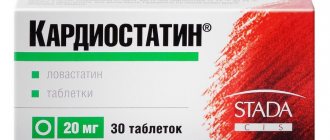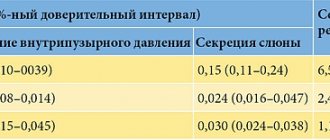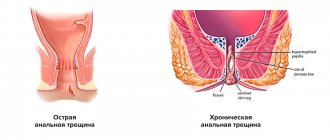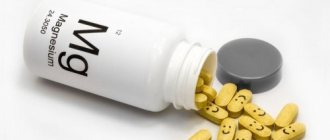Indications, contraindications and adverse reactions during treatment with Actovegin
The medication in tablets is recommended for use in patients with certain diseases:
- in complex therapy of metabolic and vascular disorders associated with dementia, ischemic stroke, circulatory failure, and head injury;
- diabetic polyneuropathy, trophic ulcers, angiopathy.
Injection solutions and droppers with Actovegin are prescribed for similar diseases and conditions as for tablets.
Direct contraindications for therapeutic procedures are:
- pulmonary edema;
- fluid retention in tissues;
- decreased daily urine production, anuria;
- individual allergic reactions to the component composition;
- heart failure in the decompensation phase.
Actovegin rarely causes adverse reactions and is well tolerated by most patients. Sometimes during treatment the following is recorded:
- swelling, urticaria, fever, sweating, hot flashes and other allergy symptoms;
- nausea with vomiting, dyspepsia, epigastric pain, stool disorders;
- state of weakness, cephalalgia, attacks of dizziness, short-term fainting, involuntary trembling of the body, decreased blood pressure or hypertensive symptoms;
- painful sensations in the chest area, paleness of the skin, shortness of breath, rapid heartbeat;
- rapid breathing, problems with swallowing, discomfort in the throat and chest, feeling of suffocation;
- pain in the lumbar area, joints and bones.
If adverse reactions to treatment occur, it is necessary to consult your doctor and replace Actovegin with an analogue.
Compound
| Film-coated tablets | 1 table |
| core | |
| active substance: | |
| deproteinized hemoderivative of calf blood | 200 mg |
| excipients: magnesium stearate; povidone-K90; talc; MCC | |
| shell: acacia gum; mountain glycol wax; hypromellose phthalate; diethyl phthalate; quinoline yellow dye, aluminum varnish; macrogol-6000; povidone-K30; sucrose; talc; titanium dioxide |
Dosages in the instructions and methods of use of Actovegin
The injection solution is used for intravenous and intramuscular administration:
- Depending on the complexity of the pathological process, Actovegin is used in dosages from 10 to 20 ml IV, then the volume changes to 5 ml. The drug is prescribed daily or several times a week.
- For metabolic and blood circulation disorders in the GM - two weeks, 10 ml every day, the next month - from 5 to 10 ml several times a week.
- Ischemic stroke, arterial angiopathy - from 20 to 50 ml mixed with infusion solution (300 ml). Therapy is carried out for 2-3 weeks.
- Trophic ulcers, burns - 5 ml IM or 10 ml IV. This dosage is prescribed 1-2 times a day, with additional local therapy with another form of Actovegin.
Prevention and treatment of skin pathologies requires daily administration of 5 ml of the product intravenously, in between radiation exposures.
The solution for infusion is prescribed according to a different scheme:
- the medicine is injected into the veins or arteries, the final doses depend on the condition of the body;
- the daily norm is 250 ml, later it is increased to 500 ml;
- The therapeutic course includes 10-20 manipulations.
The dropper speed should not exceed 2 ml per minute. The solution should not penetrate into tissues adjacent to blood vessels.
The instructions for the tablets indicate that they should not be chewed, but should be taken before meals and washed down with a small amount of liquid. From 1 to 2 pieces are prescribed three times a day, the duration of treatment is 1-1.5 months.
For diabetic polyneuropathy, the medication is administered intravenously, 2 g per day (3 weeks), then switched to tablets - up to 3 pieces per day, for 4 months.
New aspects of the use of Actovegin: from mechanisms of action to clinical effects
The results of studies evaluating the effect of the drug Actovegin on the functional activity of the microvascular endothelium, in particular the functional state of the microvascular smooth muscle apparatus, are presented. Due to its endothelial protective properties, Actovegin can be used to correct endothelial dysfunction in neurological, therapeutic, endocrinological and surgical patients.
Currently, the universality of the mechanisms of cell damage under various types of pathological influences has been proven. The final link in inflammation, ischemia, and stress is a violation of redox reactions, metabolism and energy supply to cells [1]. Today, neuroprotection, neuroplasticity and neurogenesis are considered fundamental neurobiological processes that participate in the implementation of endogenous protective activity, resist pathophysiological damaging mechanisms and stimulate endogenous recovery [2].
The classical concept of neuroprotection involves suppression of individual pathophysiological mechanisms of damage when using an appropriate drug [3]. Impaired transport and utilization of glucose is one of the leading pathogenetic mechanisms of cell apoptosis. The action of various drugs is aimed at enhancing the delivery of glucose into cells, inhibiting the oxidation of long-chain fatty acids in mitochondria and indirectly enhancing the oxidation of glucose. This leads to an increase in the synthesis of adenosine triphosphate and the neutralization of oxygen radicals, the production of which increases under ischemic conditions [4].
Today, one of the best approaches to neuroprotection is the use of pleiotropic drugs. Pleiotropic action involves a simultaneous modulating effect on various damaging pathological mechanisms (hypoxia, oxidative stress, excitotoxicity, inflammation, apoptosis and many others) [3]. The drug of biological origin Actovegin has these properties.
Actovegin is a highly purified, protein-free derivative of calf blood, obtained by ultrafiltration and consisting of more than 200 biological substances. The molecular weight of the organic compounds that make up the drug does not exceed 5000 daltons [5]. The main components of Actovegin are amino acids, biogenic amines and polyamines, sphingolipids, hexoses, eicosanoids, succinate, choline, vitamins, adenosine monophosphate, inositol phosphooligosaccharides, as well as macroelements (magnesium, sodium, calcium, phosphorus) and neuroactive microelements (silicon, copper). The macro- and microelements that make up Actovegin are part of neuropeptides, enzymes and amino acids, and therefore are recognized and absorbed by neurons much better than macro- and microelements that enter the body in the form of salts.
The metabolic effect of Acto-vegin consists primarily of enhancing the utilization of oxygen and the transfer of glucose into cell mitochondria. Various experimental models have shown that Actovegin, by influencing oxidative phosphorylation in mitochondria, increases oxygen production by cells by almost 40% [6, 7]. In addition, Actovegin is able to enhance the transport of glucose into the cell. It was found that the active fraction of the drug, including inositol phosphooligosaccharides, activates the transport of glucose into the cell through the activation of transport proteins (GLUT1, GLUT4), without involving insulin receptors. This is of great clinical importance, for example, in type 2 diabetes mellitus against the background of insulin resistance [8].
Actovegin has a neuroprotective effect and, in particular, has a pronounced antioxidant effect. According to in vitro data, Actovegin improves metabolism in cells, increases the number of neuronal synapses, reduces the level of markers of apoptosis induction (caspase 3) and the formation of reactive oxygen species in cells. These effects are dose-dependent [9, 10]. Similar results were obtained in recent experimental work.
MM. Yurinskaya et al. (2014) found that the use of Actovegin leads to a decrease in apoptosis of human neuroblastoma cells induced by hydrogen peroxide and suppression of intracellular signaling pathways involved in the mechanism of cell death [11].
L.G. Khaspekov et al. (2014) [12], studying the protective effect of Actovegin in a model of glutamate toxicity, found that the drug at a dose of 1 mg/ml has a neuroprotective effect, expressed in a decrease in cell death and most likely associated with the action of glutamate in rat cerebellar neurons.
Actovegin also demonstrated a neuroprotective effect in severe neuropathy in a model of streptozotocin-induced diabetes in rats. According to A. Dieckmann et al. (2011), Actovegin significantly improved conductivity in sensory nerve fibers and reduced the activity of poly-ADP-ribose polymerase, a nuclear enzyme whose excessive activation can trigger cell death processes in conditions such as cerebrovascular diseases and diabetic polyneuropathy [13].
In a study by S. Mielin et al. (2014) on a model of total cerebral ischemia in rats with occlusion of four main arteries of the brain, Actovegin contributed to better survival of neurons in the CA1 zone of the hippocampus compared to placebo [14]. This observation was accompanied by a large number of surviving individuals in the Actovegin group and significantly better results in the Morris water maze test.
In addition to Actovegin’s ability to improve cellular metabolism and have a neuroprotective effect, a number of studies have noted the drug’s effect on the microvascular endothelium.
In a pilot study by A.A. Fedorovich on 28 healthy volunteers, it was revealed that Actovegin has a direct endothelial protective effect at the level of the microvascular bed [15]. The obtained results were subsequently confirmed in a population of patients with obliterating diseases of the arteries of the lower extremities, as well as with arterial hypertension.
According to the results of another study, intravenous infusions of Actovegin improved microcirculation parameters due to the endothelial protective effect and had a positive effect on the course of the disease. Patients receiving the drug were able to walk longer distances without pain [16].
The effectiveness of the drug was assessed in patients with arterial hypertension and moderate vascular cognitive impairment. Despite adequate lipid-lowering and antihypertensive therapy with the achievement of target blood pressure levels, cognitive disorders persisted in the comparison group (decrease in voluntary attention indicators), while in the Actovegin group it was possible to level out the cognitive deficit. In addition, during Actovegin therapy, a significant increase in the number of functioning capillaries at rest was noted, that is, a decrease in the elements of functional rarefaction of the microvasculature observed in patients with arterial hypertension [17].
V.V. Zakharov and V.B. Sosnin assessed the therapeutic effect of Actovegin on cognitive functions in patients with type 2 diabetes mellitus [18]. The patients were divided into two subgroups: the first - with the presence of concomitant arterial hypertension, signs of coronary heart disease and hemodynamically significant stenosis of the carotid arteries, the second - with the absence of the above pathology. After a three-month course of therapy, the greatest dynamics in indicators of concentration, short-term memory, visual-motor coordination and regulation of mental activity were observed in the group of patients in whom diabetes was combined with other clinically significant cardiovascular risk factors. Cognitive impairment in this category of patients, along with other factors, is based on tissue hypoxia caused by micro- and macrovascular damage. It is likely that Actovegin may have an additional positive effect in vascular cognitive disorders associated with damage to small vessels by improving microcirculatory parameters.
Thus, based on a number of experimental and clinical data, we can conclude that Actovegin, having many positive effects (antihypoxic, metabolic, neuroprotective and endothelial protective), is one of the promising drugs for the correction of hypoxic-ischemic damage, endothelial dysfunction, and microcirculatory disorders. Actovegin can be recommended as the drug of first choice for neurological and therapeutic patients: with acute or chronic cerebral ischemia and concomitant cardiovascular diseases, diabetes mellitus complicated by diabetic polyneuropathy, moderate and severe cognitive impairment in persons who have suffered a stroke. Therapeutic regimens used for the use of Actovegin in chronic ischemic conditions: 10–20 ml (400–800 mg) per 200 ml of saline intravenously in a course of seven to ten days, then one or two tablets (200–400 mg) three times a day within one to two months. In the presence of mnestic-intellectual disorders in elderly people - up to 12 weeks, two to three tablets three times a day. Repeat courses after six to eight months.
Pharmacokinetics
Using pharmacokinetic methods, it is impossible to study the pharmacokinetic parameters of the drug Actovegin®, since it consists only of physiological components that are usually present in the body.
To date, a decrease in the pharmacological effect of hemoderivatives has not been found in patients with altered pharmacokinetics (for example, hepatic or renal failure, changes in metabolism associated with old age, as well as metabolic characteristics in newborns).
Release form
Film-coated tablets, 200 mg. 50 tablets each in dark glass bottles with a screw neck, sealed with aluminum caps with first opening control. 1 fl. placed in a cardboard pack.
In the case of packaging and packaging of the drug at Takeda Pharmaceuticals LLC, Russia: 50 tablets each. in dark glass bottles with a screw neck, sealed with aluminum caps with first opening control. 1 fl. placed in a cardboard pack. Transparent round protective stickers with holographic inscriptions and first-opening control are glued to the pack.
In the case of packaging and/or packaging of the drug at Pharm CJSC - 10, 30, or 50 tablets. in dark glass bottles with a screw neck, sealed with aluminum caps with first opening control. 1 fl. placed in a cardboard pack.
Pharmacodynamics
Antihypoxant. Actovegin® is a hemoderivative, which is obtained through dialysis and ultrafiltration (compounds with a molecular weight of less than 5000 Da pass through).
It has a positive effect on the transport and utilization of glucose, stimulates oxygen consumption (which leads to the stabilization of plasma membranes of cells during ischemia and a decrease in the formation of lactate), thus has an antihypoxic effect, which begins to manifest itself no later than 30 minutes after oral administration and reaches a maximum in on average after 3 hours (2–6 hours).
Actovegin® increases the concentrations of ATP, ADP, phosphocreatine, as well as amino acids - glutamate, aspartate and GABA.
The effect of Actovegin® on the absorption and utilization of oxygen, as well as insulin-like activity with stimulation of glucose transport and oxidation are significant in the treatment of diabetic polyneuropathy (DPN).
In patients with diabetes mellitus and DPN, Actovegin® significantly reduces the symptoms of polyneuropathy (stabbing pain, burning sensation, paresthesia, numbness in the lower extremities).
Sensitivity disorders are objectively reduced and the mental well-being of patients is improved.







